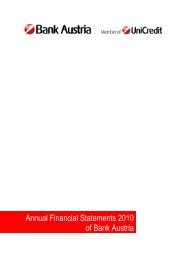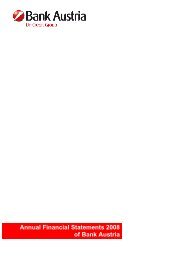Annual Financial Statements 2011 of Bank Austria
Annual Financial Statements 2011 of Bank Austria
Annual Financial Statements 2011 of Bank Austria
Create successful ePaper yourself
Turn your PDF publications into a flip-book with our unique Google optimized e-Paper software.
Notes to the <strong>Financial</strong> <strong>Statements</strong> <strong>of</strong> UniCredit <strong>Bank</strong> <strong>Austria</strong> AG<br />
In the second quarter <strong>of</strong> <strong>2011</strong>, UniCredit <strong>Bank</strong> <strong>Austria</strong><br />
AG was granted permission by the <strong>Austria</strong>n<br />
supervisory authority to replace the risk model<br />
("NoRISK") developed by the bank itself, which has<br />
been used for many years, with the new IMOD model<br />
used within the entire UniCredit Group. This switch<br />
constituted a significant change <strong>of</strong> model in<br />
accordance with Section 21e <strong>of</strong> the <strong>Austria</strong>n <strong>Bank</strong>ing<br />
Act. The new model is based on historical simulation<br />
with a 500-day market data time window for scenario<br />
generation. It is currently used on a uniform basis by<br />
many UniCredit Group subsidiaries. The model is<br />
applied by Market Risk within UniCredit <strong>Bank</strong> <strong>Austria</strong><br />
AG and is being further developed in cooperation with<br />
the UniCredit holding company. The conditions<br />
imposed by the college <strong>of</strong> supervisors (Italy, Germany,<br />
<strong>Austria</strong>) in the course <strong>of</strong> the approval process for the<br />
new model were largely fulfilled in <strong>2011</strong>. Moreover, in<br />
<strong>2011</strong> an application was filed with the regulators (BoI<br />
and FMA) for permission to use the models developed<br />
in UniCredit Group to comply with the new CRD 3 rules<br />
for the trading book which have been applicable since<br />
December <strong>2011</strong>. This applies in particular to the<br />
stressed VaR and IRC (incremental risk charge), while<br />
CRM (comprehensive risk measure) is not applicable<br />
to UniCredit <strong>Bank</strong> <strong>Austria</strong> AG for lack <strong>of</strong> credit-tranche<br />
holdings in the trading book. The relevant reviews in<br />
<strong>Bank</strong> <strong>Austria</strong> were completed by the <strong>Austria</strong>n<br />
supervisory authority with a positive outcome in <strong>2011</strong>.<br />
Approval for use <strong>of</strong> the new models was given as at<br />
year-end <strong>2011</strong>.<br />
As at 30 December <strong>2011</strong>, VaR at UniCredit <strong>Bank</strong><br />
<strong>Austria</strong> AG for the respective risk categories was as<br />
follows (calculated on the basis <strong>of</strong> the new model):<br />
(in EUR)<br />
Exchange rate risk, overall -1,321,717.24<br />
Equity position risk, trading book 0.00<br />
Equity position risk, banking book -11,408,788.71<br />
Interest rate position risk, trading and banking books -6,372,392.61<br />
Credit spread risk (VaR limit scope) -32,968,618.29<br />
Overall market risk (VaR limit scope) -43,300,668.00<br />
Overall market risk arising from the above components -55,831,924.84<br />
The above figures are based on the new internal<br />
Group-wide model.<br />
For the purpose <strong>of</strong> determining capital requirements,<br />
the new model has been used since April <strong>2011</strong>. The<br />
parameters used in this context are a 10-day holding<br />
period, a confidence level <strong>of</strong> 99% and a multiplier <strong>of</strong><br />
3.5. As at 30 December <strong>2011</strong>, the capital requirement<br />
was EUR 43.9 m.<br />
The following capital requirements result for UniCredit<br />
<strong>Bank</strong> <strong>Austria</strong> AG in connection with S-VaR and IRC:<br />
EUR 67.0 m for S-VaR and EUR 21.4 m for IRC.<br />
Within the <strong>Bank</strong> <strong>Austria</strong> Group, the reliability and<br />
accuracy <strong>of</strong> the internal model is monitored by daily<br />
backtesting, comparing the VaR amounts with the<br />
actually observed fluctuations in market parameters<br />
and in the total value <strong>of</strong> the trading books. In <strong>2011</strong>,<br />
there was no negative backtesting excess. The results<br />
<strong>of</strong> backtesting have thus confirmed the accuracy and<br />
reliability <strong>of</strong> the model. The multiplier <strong>of</strong> <strong>of</strong> 3.5 therefore<br />
remains unchanged.<br />
Value-at-risk calculations are complemented by<br />
various stress scenarios to identify the potential effects<br />
<strong>of</strong> stressful market conditions on the Group’s earnings.<br />
The assumptions made under such stress scenarios<br />
include extreme market movements and a dramatic<br />
deterioration in market liquidity.<br />
Market risks resulting from the general balance sheet<br />
structure and the positioning <strong>of</strong> asset-liability<br />
management are additionally determined and regularly<br />
analysed by means <strong>of</strong> simulations <strong>of</strong> net interest<br />
income volatility. In addition to the business volume at<br />
the reporting date, these simulations are based on<br />
various interest rate scenarios, assumptions regarding<br />
new business, demand behaviour and general<br />
developments affecting margins in those market<br />
segments which are <strong>of</strong> greatest importance to<br />
UniCredit <strong>Bank</strong> <strong>Austria</strong> AG. Modelling over the<br />
projection period provides indications <strong>of</strong> trends in net<br />
interest income and enables the bank to identify risks<br />
at an early stage and to take appropriate measures.<br />
In addition to calculating VaR for trading activities, the<br />
bank uses the Value-at-Risk method for measuring<br />
market risk in the banking book.<br />
<strong>Bank</strong> <strong>Austria</strong> – <strong>Annual</strong> <strong>Financial</strong> <strong>Statements</strong> <strong>2011</strong> 229
















